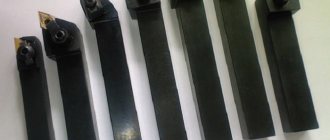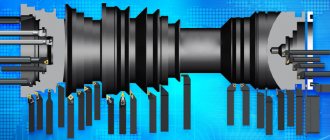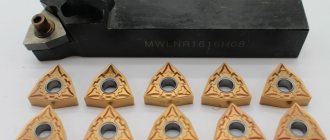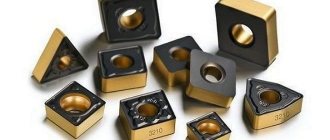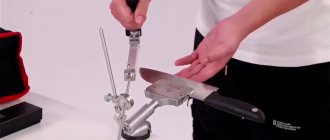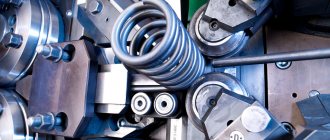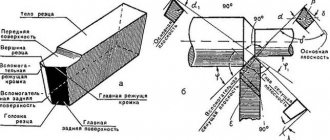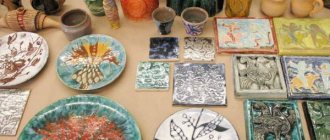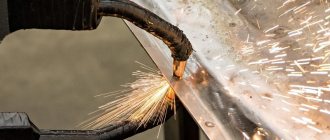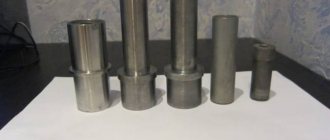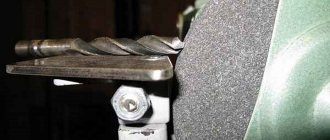Brief information about metal powders
Metal powders are small crystalline grains (fractions) ranging in size from 10 to 500 microns, sometimes up to 1 mm.
The grains can be needle-shaped, spherical, hollow spherical, lamellar or scaly in shape. The physicochemical and technological properties of metal powders are determined by their chemical composition, pycnometric density, structure, mass fraction of impurities, gases, metal and other contaminants of the powders. Metal powders are the basis for the production of carbide materials. They are produced both from pure metals (chrome, nickel, cobalt, molybdenum, vanadium, etc.) and from metal carbides (tungsten, titanium, tantalum carbides). The industry that produces powders (hard alloy materials) is called powder metallurgy. The following methods for producing carbide materials are used in powder metallurgy:
- physico-chemical;
- thermometallurgical;
- mechanical;
- combined.
Powder metallurgy includes two independent branches of production. The first is the production of various powdery materials (powders, grains, granules, electrodes, monoliths and semi-finished products). The second is the processing of powdered materials into products (turning and milling inserts, blanks for monolithic tools, attachments for drilling and cutting tools, dies, electrode materials, monoliths, electrical contacts and various structural products).
Currently, powder metallurgy has established the production of various products from carbide materials, including high-purity filters, friction and anti-friction parts, plates for surfacing cutting, impact, drilling, abrasive and other tools.
High-alloy structural and tool steels are produced on the basis of powder metallurgy, for example, steel grade X23N18. Products from this steel are made by sintering powders. Steel is used for the manufacture of sliding bearings (liners). After chemical-thermal treatment (sulfiding or boriding) of these liners, scuffing and adhesion are eliminated and softness of shaft sliding is created. Such a pair can operate at elevated temperatures (up to 600 °C) and in aggressive environments.
For the manufacture of sealing parts (rings, gaskets, liners), steels based on the chromium-nickel-graphite system, obtained from metal powders, are used. These parts are used in gas turbines and apparatus. They withstand exposure to active gas environments, high temperatures and pressures.
Alloys made from powders based on chromium, nickel and titanium (X65N32, X66N30T4, X68N20T2, etc.) are used for the production of electrodes (welding structures made of high-alloy steels operating in aggressive environments and at high temperatures). High-alloy powders are also used to produce tool high-speed steels (R6M5F3, R6M5K5, R12MF5, R12M3F2K8, etc.), which are used for the manufacture of solid cutting tools for processing parts and workpieces made of high-strength and heat-resistant, including corrosion-resistant steels and alloys. Practice shows that the cutting properties of tools made from these steels are significantly higher than those from steels obtained by melting and subsequent rolling. They withstand high cutting conditions at elevated temperatures, their red hardness is more than 600 °C. For example, a tool made of steel grade R6M5K5 at an operating temperature of 650 °C will have a hardness of 52 HRA. If the tool life of a tool made of steel R6M5K5, made by casting and rolling, at a temperature of 650 °C and a hardness of 52 HRA is 240 minutes, then a tool of the same brand, made from powders, under the same cutting conditions will have a tool life significantly higher (approximately 360 ... 420 minutes ).
Powder metallurgy has also mastered the production of tungsten-free high-speed steels (Р0М6Ф1, Р0М2Ф3, Р0М10Ф3, etc.). These steels are much cheaper because they do not contain expensive tungsten. They have a dense, fine-grained and stable structure. Tools made from these steels have higher durability and red resistance.
Carbon steels
Carbon tool steels are marked with the letter Y, and the number following it shows the carbon content in tenths of a percent. For the manufacture of tools, high-quality carbon steels of grades U7-U13 and high-quality steels of grades U7A-U13A are used. High-quality steels contain no more than 0.02% sulfur and phosphorus, high-quality steels - no more than 0.03%. According to their intended purpose, carbon steels are distinguished for use under shock loads and for statically loaded tools. Steel grades U7-U9 are used for the manufacture of tools when working with shock loads, which require high cutting ability (chisels, metal stamps, woodworking tools, in particular saws, axes, etc.). Steel grades U10-U13 are used for the manufacture of cutting tools that do not experience shocks or shocks during operation and have high hardness (files, scrapers, sharp surgical instruments, etc.). Simple cold-forming dies are sometimes also made from steel of these grades. Carbon hypoeutectoid steels, after hot plastic processing (forging or rolling) and subsequent cooling in air, have a structure consisting of lamellar pearlite and a small amount of ferrite, and hypereutectoid steels have lamellar pearlite and excess cementite, which usually forms a continuous or discontinuous network along the boundaries of the former grains austenite. Heat treatment of carbon tool steels consists of two operations: preliminary and final treatments. Preliminary heat treatment of steels consists of annealing at 740-760 °C, the purpose of which is to obtain a microstructure consisting of granular pearlite - pseudo-perlite, since with such a microstructure after subsequent hardening the most uniform properties are obtained. In addition, this structure facilitates the machining of the tool. The final heat treatment consists of hardening and low tempering. Quenching is carried out in water from 780-810 °C, that is, at temperatures for hypoeutectoid steels lying slightly above LS3, and for hypereutectoid steels lying below Ast.
Carbon steels have a very high critical hardening rate - about 200-300 °C/s. Therefore, even the slightest slowdown in cooling during hardening is unacceptable, since this can lead to partial decomposition of austenite at temperatures in the pearlite range and, as a consequence, to the appearance of soft spots. The decomposition of austenite occurs especially quickly in carbon steels at temperatures close to 500–550 °C, where it begins almost instantly, proceeds extremely intensely, and ends completely within a few seconds. Therefore, only tools of small diameter can be heated through and through after quenching in water. However, at the same time, large internal stresses arise in them, which can cause significant deformations. Tools that are large in size, when quenched in water and in aqueous solutions of salts, acids and alkalis, the cooling capacity of which is higher than water, are hardened to martensite only in a thin surface layer. The structure of the deep zones of the tools represents the products of austenite decomposition in the pearlite temperature range. The core of tools having this structure is less brittle compared to the martensitic structure. Therefore, tools with such a core can withstand shocks and impacts better than tools hardened through martensite. Carbon steels are most appropriately used for tools with a small cross-section (up to 5 mm), which can be quenched in oil and achieve through hardenability, as well as for tools with a diameter or minimum thickness of 18-25 mm, in which the cutting part is only on the surface layer, for example files, countersinks, taps. Carbon tool steels are tempered at temperatures not exceeding 200 °C to avoid a decrease in hardness. The hardness of a finally heat-treated tool made of carbon steels usually lies in the HB.C range of 56–64. The advantages of carbon tool steels are low cost, good workability by pressure and cutting in the annealed state. Their disadvantages are low cutting speeds, limited tool sizes due to low hardenability, and significant deformations after quenching in water.
8.2. Classification of hard alloys and mineral-ceramic materials
Hard alloys and mineral-ceramic materials are a large group of structural and instrumental materials obtained from metal and other powders. Products obtained through the powder metallurgy production process are called sintered.
Sintered cemented carbides are materials consisting of carbides (a chemical compound of carbon with various metals) of tungsten, titanium and tantalum pressed into pure cobalt metal. Hard alloys have high hardness, strength, cutting and other properties and retain them when heated to high temperatures. Their hardness is significantly higher than that of other materials and approaches the hardness of diamond. Possessing such high physical, chemical, mechanical, technological and operational properties, they find very wide application in the tool, machine-building and metalworking industries.
Hard alloys are classified according to the following parameters:
- by purpose - instrumental, structural, (surfacing, casting), friction, antifriction, magnetic, electrical, for filters, devices, as well as materials used for the manufacture of wear parts of devices, machines and structures, matrices for the synthesis of diamonds, etc. A special group constitute solid sintered tool materials for the following types of work: processing of metals and other materials by cutting (lathes and other cutters, drills, cutters, including modular ones, broaches, reamers, planing knives, knurling, sheving, etc.); mining work (drills for screws and wells, chisels for jackhammers, cutters for coal miners, cutters for drilling, knives, saws, cutters for stone processing, etc.); forging and pressing, rolling and stamping works (multi-position strands, punches, dies, dies, dies, knives, saws, cutters, rolling rollers, including shaped, drawing boards, etc.); woodworking (frame saws, cutters, centering, milling hooks, planing knives, etc.);
- by chemical composition (charge material) - metal (alloyed, high-speed tungsten, high-speed tungsten-free, iron-nickel, chromium-nickel, etc.), metal-ceramic (chromium carbide, titanium carbide, tungsten, titanium-tungsten, titanium-tantalum tungsten, etc.), mineral-ceramic (microlite, cermets, oxide and oxide-carbide ceramics, etc.);
- by type of material produced - powder (granular), rod, tubular, electrode, monolithic, various types of blanks and finished products;
- by the method of processing into products - cold pressing, hot pressing, hydrostatic pressing, die pressing, vacuum compression sintering and rolling of metal powders;
- by properties - red-resistant (heat-resistant), chemically resistant (corrosion-resistant) and carbide.
Red-resistant alloys consist of metal carbides (tungsten, titanium, tantalum, etc.), mineral ceramics and cobalt, aluminum and iron, chemically resistant alloys - of nickel, titanium, silicon, etc.
Carbide and mineral-ceramic materials are also divided into:
- to hard, or increased hardness (1,500 ... 2,000 HV), which are produced from powders of tungsten, titanium, tantalum carbides, alloy steels, iron and other metals and their carbides;
- very high hardness (2,000 ... 2,500 HV), usually related to abrasive materials (silicon carbide, electrocorundum, etc.);
- very hard (more than 2,500 HV), intended for both abrasives and cutting tools (natural and artificial diamonds, cubic boron nitride, etc.).
A special group in powder metallurgy (cermets) consists of hard sintered tool materials produced in the form of replaceable polyhedral plates (SMP) for turning, milling and drilling. Replaceable multifaceted inserts are equipped with end metal-cutting, drilling and slotting tools, as well as milling cutters, broaches, reamers, planing knives, cutters for processing railway wheels and rails, knurling and shewings.
Depending on the characteristics of the material being processed and the type of chips being removed, cutting tools made of hard sintered alloys are divided into ISO application groups with a numerical index. Application groups take into account mechanical properties: hardness, strength, elasticity, machinability, etc. and are designated by one of the following letters: P, M, K, N, S and H of the main cutting group and a numerical index: 01, 05, 10, 15, 20 , 25, 30, 35, 40, 45, 50.
Tool application groups correspond to the following processed materials:
P - carbon steels of all groups and grades, low-alloy steels, high-alloy and tool steels after annealing, bearing and electrical steel, cast steel, corrosion-resistant steel and malleable cast iron, during turning of which drain chips are formed;
M - corrosion-resistant steels (ferritic, martensitic and austenitic), cast steel, free-cut steel, as well as low-alloy and malleable cast iron, during the processing of which elemental chips are formed;
K - gray, malleable and high-strength cast irons of ferritic and pearlitic classes, during processing of which fracture chips are formed;
N - pure aluminum, wrought and cast aluminum alloys, silumin with a silicon content of 8% or more, as well as copper and copper alloys (brass and bronze); when processing these metals, long, draining chips are formed;
S - titanium and its alloys (technically pure titanium, alpha alloys, alpha + beta alloys, heat-resistant alloys based on iron, nickel and cobalt, during processing of which elemental chips are formed; H - hard materials (hardened steel and bleached cast iron of the ChH group, ChN and ChS), during processing of which loose chips are formed.
The numerical index characterizes the change in the type of processing, cutting mode and properties of the tool carbide alloy.
When choosing a grade of carbide, you should take into account the type and characteristics of the material being processed, cutting modes and technical characteristics of the equipment, its technological capabilities. The higher the index number in the designation of the application group, the lower the wear resistance of the carbide and the permissible cutting speed, but the higher the strength of the carbide and the permissible feed and depth of cut.
Materials for cutting tools
In the process of cutting metals, the cutting tool is subjected to high pressure from the cut layer and heat, which causes its wear. Therefore, the main requirement for cutting tool materials is wear resistance at high heating temperatures for a long time. This requirement is ensured by the high hardness of the material in the heated state and its red resistance.
Currently, in mechanical engineering, tool carbon, alloy and high-speed steels are used for the manufacture of cutting tools. In addition to the listed steels, plates of hard metal-ceramic and mineral-ceramic materials are also used.
Tool carbon steels currently have limited use due to their low red resistance. Although tools made from this steel have a hardness after heat treatment of HRC 60 - 63, when heated to 200 - 250°C, the hardness drops sharply and the tool becomes dull.
Cutting tools operating at low cutting speeds (V ≤ 10 m/min), for example files, hacksaw blades, taps, dies, etc., are made from tool carbon steel grades U10A, U12A.
Alloyed tool steels differ from carbon tool steels in that they contain alloying metals: chromium, tungsten, molybdenum, vanadium, nickel, etc. These steels contain 0.85 ÷ 1.5% C. After hardening, they have a hardness of HRC 62 - 64, have high viscosity and high mechanical properties σпч = 160 - 170 kg/mm2. However, their red resistance does not exceed 350 - 400 ° C, therefore these steels are used in the manufacture of cutting tools for metal processing (bleached cast iron, cold-worked steel, etc.) at low and moderate cutting speeds (approximately 1.2 ÷ 1.5 times greater than when working with tools made of tool carbon steel). Alloyed chromium-silicon steel 9ХС and especially chromium-tungsten grades ХВГ and 9ХВГ are little deformed during hardening, which is very important in the manufacture of such complex cutting tools as broaches, long reamers, taps, drills, cutters, etc.
High-speed steels are chrome-tungsten steels with a tungsten content of 8.5 to 19% and chromium from 3.8 to 4.4%. Cutting tools made of high-speed steels have a hardness of HRC 62 - 65 after heat treatment, increased wear resistance and retain cutting properties when heated to 600 - 650°C. This allows you to work with tools made of high-speed steel at speeds 2 to 4 times higher than with tools made of tool carbon steel.
Currently, high-speed steels of the P9 and P18 grades with an average tungsten content of 9 and 18%, respectively, are widely used. In addition to these main grades, when processing heat-resistant and other alloys, cobalt and vanadium tool high-speed steels of the grades R9F5, R14F4, R18F2, R8K5, R9K10, R10K5F5, R18K5F2 are used.
In the given brands, the letter P stands for tungsten, the letter F stands for vanadium, the letter K stands for cobalt, and the numbers following the letter indicate the percentage of this metal. For example, steel grade R10K5F5 contains ten percent tungsten, five percent cobalt and five percent vanadium.
Hard alloys are a solution of tungsten carbides and titanium carbides in metallic cobalt. They are produced in the form of plates of the required shape by sintering at a temperature of about 1900°C. The resulting plates have a very high hardness HRC 88 - 92, high wear resistance and red hardness (900 - 1000°C). Hard alloy plates are soldered or mechanically secured with special clamps to a body (holder) made of structural or instrumental carbon steel (U7A, U8A).
Cutting tools with carbide inserts are used to process the hardest metals, including hardened steel and non-metallic materials (glass, porcelain, plastics) at cutting speeds 3 to 4 times higher than the processing speed of high-speed steel tools. Currently, hard metal factories alloys are produced by two main groups of these alloys: the tungsten group, the main grades of which are VK2, VKZ, VK4, VK6, VK6M, VK8, VK8V, and the titanium-tungsten group with the main grades T5K10, T5K12V, T14K8, T15K6, T30K4 and T60K6, and the tantalum-titanium-tungsten TT7K12 . Hard alloys of the VK group are intended for processing cast iron and other hard, brittle metals and non-metallic materials; TK group alloys are intended for processing steels.
In all the given grades of hard alloys, the numbers after the letter K indicate the cobalt content as a percentage, and the numbers after the letter T indicate the titanium carbide content as a percentage; the rest up to 100% is tungsten carbides. For example, the VK6 hard alloy contains 6% cobalt and 94% tungsten carbides; alloy T60K6 - 60% titanium carbide, 6% cobalt and 34% tungsten carbide. Among the listed grades of hard alloys, grades VK4, VK6M and VK8V were included in GOST in 1958. They are intended for cutting metals and non-metallic materials and for a number of properties - hardness , operational strength and wear resistance - superior to some old brands of hard alloys (VKZ, VK6, VK8).
Mineral-ceramic material for the manufacture of plates for cutting tools consists of aluminum oxide (Al2O3) and is obtained by pressing followed by heat treatment. Mineral-ceramic plates are mechanically attached to metal holders or soldered, having previously been subjected to metallization. In industry, mineral ceramic plates of the T-48 and TsM-332 brands are used. These materials, having a very high hardness (HRC 91 - 93) and a red hardness of 1200ºC, allow metals to be processed at cutting speeds of up to 2000 m/min, i.e., 1.5 - 2 times higher than the cutting speed of hard alloys. But a significant disadvantage of the mineral-ceramic material is its high fragility, which prevents its widespread introduction into industry.
Mineral-ceramic materials are most effectively used for cutting tools for semi-finishing and finishing machining of steel, cast iron and non-ferrous metals under non-impact loading conditions.
Innovative technologies in the production of hard alloys
Currently, enterprises producing hard alloys are introducing progressive technologies that make it possible to supply hard alloy inserts to the market, including the international market, to equip various cutting tools with them. For example, at the Kirovgrad Hard Alloy Plant OJSC (Sverdlovsk region), together with the Institute of Solid State Chemistry of the Ural Branch of the Russian Academy of Sciences and other research institutes of the Russian Federation, a set of measures has been developed, the implementation of which makes it possible to produce hard alloy plates that are not inferior in quality to the products of Western companies. Nanostructured hard alloys are being developed to replace conventional fine-grained hard alloys used in the production of metal-cutting, drilling, stamping, end and other tools. Import-replacement metal-cutting inserts, which are in great demand among machine-building enterprises, are also being introduced into production.
Technologies have been introduced and new equipment has been mastered, such as spray drying of carbide mixtures, vacuum-compression sintering furnaces, an attritor for preparing mixtures, a press with robotic removal of parts, installations for coating, a fleet of ultra-precision grinding equipment, etc. All this in a single complex is aimed at production of high-tech products - replaceable multifaceted inserts with a high degree of accuracy, with new geometry of the front surface, new chipbreakers and wear-resistant coatings, high volumetric porosity (0.02% instead of 0.2%).
Recently, the Kirovograd Hard Alloy Plant OJSC has mastered the production of 44 types of high-precision replaceable multifaceted inserts. The consumers of these plates are about 40 machine-building, metalworking and tool enterprises, such as OJSC NPK Uralvagon, OJSC Tomsk Instrumental, etc. Reviews about the quality and reliability of metal-cutting tools, their performance properties coming from consumer enterprises are positive. In addition, the plant entered the international market with its products. Let's take a brief look at some of the innovative technological processes being implemented at KZTS OJSC.
- Development of nanostructured hard alloys. Thanks to the introduction of this technology, the problem of further economical use of expensive tungsten, titanium-tungsten and titanium-tungsten hard alloys has been solved; on their basis, the production of new materials with higher properties has been mastered.
- Production of carbide rods for monolithic tools (mills, drills, taps, etc.). For these purposes, a new submicron alloy has been created, which has been assigned the grade A04 and its modification A04-6 (Table 8.1). These alloys are created by modifying the carbide mixture by adding tungsten carbide nanopowder (60 nm). This alloy in its physical, mechanical and operational properties is not inferior to analogues produced by world leaders in the production of hard alloys.
- The use of vacuum-compression sintering furnaces makes it possible to obtain a virtually pore-free alloy. This is achieved by compressing the products during the sintering process with argon pressure of 50 bar. A decrease in volumetric porosity from 0.2% to 0.02% results in an increase in physical and mechanical properties and operational durability by 10 ... 20%.
- The introduction of mixture drying units by spraying HC120 (NIRO A/S, Denmark) made it possible to obtain a better granulometric composition of the carbide mixture fractions. At the same time, hard, dangerous and unproductive labor of workers was eliminated, which led to a sharp increase in labor productivity and the preservation of people's health.
| Table 1. Properties of innovative submicron alloys A04 and A04G6 | |||||
| Alloy grade | Hardness HRA, not less | Density, g/cm2 | Bending strength, kgf/mm2 (N/mm2), not less | Coercive force, no less | |
| kA/m | Oersted | ||||
| A04 | 92,0 | 14,35 … 14,6 | 270 (2 646) | 23,9 | 300 |
| A04-6 | 93,0 | 14,7 … 15,0 | 150 (1470) | 25,6 | 320 |
High performance properties of cutting tool inserts are achieved through a combination of design, grade of carbide, application method and type of wear-resistant coating. Modern wear-resistant coatings used to cover imported replacement plates, which have been tested at machine-building plants, have shown high quality.
The highest performance qualities are achieved by coatings created using technology for applying wear-resistant mono- and multi-coatings to plates and end tools:
- by chemical vapor deposition (CVD);
- using ion plasma coating (PVD) method. Mono- and multi-coatings of inserts and end tools are made on the basis of the following materials: TiN, TiCN, TiAlN, AlTN, TiAlSiN, Al2O3, etc. These coating materials are used in various combinations.
For the chemical vapor deposition (CVD) method, a BERNEX BPXpro 530 LT unit (Germany) is used. This method is used to coat turning inserts. The CVD method produces coatings of several types:
- CVD coating type RT - golden color, four-layer (two layers of titanium nitride and one layer each of titanium carbonide and aluminum oxide), wear-resistant. The titanium carbonide layer ensures strong adhesion of the coating to the carbide plate, maintaining viscosity and adhesion at high temperatures. Titanium carbonide imparts toughness to the cutting edge and resistance to peeling and chipping. Aluminum oxide has high hardness, low adhesion and high heat resistance. This coating can withstand dynamic loads, impacts and is used for processing castings and forgings;
- CVD coating type RT-R - black and gold color. The front surface of the SMP is coated with aluminum oxide, has a black color, a polished surface, which facilitates easy chip flow and removal of heat from the cutting zone. The back surface is yellow in color and coated with a wear-resistant layer of titanium nitride. The appearance of black marks on the back surface during operation indicates wear of the cutting edge.
Other types of CVD coatings are also used.
A cutting tool equipped with CVD-coated inserts, depending on the type and composition of the coating material, has the following properties:
- thickness of coating layers - from 0.1 to 3.9 microns;
- maximum temperature of use (red resistance) - 720 ... 1,050 ° C;
- microhardness - 2,600 ... 3,000 HV;
- friction coefficient - 0.15...0.32.
The PVD ion plasma deposition method produces two types of coatings: TT and AM. The TT type coating is golden-colored, three-layer (two layers of titanium nitride (TiN) and one layer of a complex TiAlN compound). Used for coating milling inserts and end tools. Depending on the composition of the material, these coatings have the following properties:
- thickness of coating layers - from 0.1 to 3.9 microns;
- maximum temperature of use (red resistance) - 600 ... 1,200 ° C;
- nanohardness - 24 ... 45 GPa;
- friction coefficient - 0.5 ... 0.7;
- high adhesion, Rockwell hardness and scratch test (N).
The AM type coating is dark purple in color and consists of numerous multilayers of AlTiNi and TiAlNi compounds. Such multilayer coatings are used for tools used for intermittent cutting of metals, unstable conditions and high mechanical loads. Designed for milling tools when processing castings, forgings and stampings (carbon, alloyed, corrosion-resistant and other steels).
When tested at JSC NPK Uralvagonzavod, cutting tools manufactured on the basis of new technologies showed durability 1.8 times higher than the basic durability of conventional carbide tools. Tests of cutting tools equipped with inserts with a new geometry of the front surface and new chipbreakers, carried out at JSC NPO ISKRA, showed the high durability of such inserts, namely 578 minutes, which significantly exceeds the level of durability of inserts produced by Western companies. It should be noted that the maximum durability of turning cutters equipped with carbide inserts of types VK, TK or TTK is 120 minutes. Positive results were obtained when testing inserts for roughing on machines at Belebeevsky. The durability of the plates is increased by 60%. The durability of tangential plates when processing carriage wheels at JSC NPK Uralvagonzavod increased by 20%.
Innovative technologies, chemical composition of plates and coatings introduced by hard alloy plants are radically changing traditional ideas about hard alloys. In this regard, new designations of plates made of hard alloys are used, namely: A05 (VK3-M), A10 (VK60-M), A20 (VP322), A30 (VK10-OM), B20 (MS321), B25 (VK6) , V35 (VK8), N05 (T30K4), N10 (T15K6), N20 (T14K8), N30 (T5K10), T20 (MS221), T25 (MS137), T30 (TS125), T40 (MS146), T50 (TT7K8) . (The old designations of analogues of hard alloy grades are given in parentheses.)
The alphanumeric designation adopted for the marking of new alloys is:
1st character (letter) - alloy group: N-TK-alloys; T-TTK, M, TSalloys; V-VK-alloys; A-fine-grained VK alloy;
2nd character (letter) - coating method: C - chemical vapor deposition (CVD); P — ion-plasma coating (PVD);
3rd and 4th digits - main ISO application group (P, M, K, N, S, H) and numerical index: 01, 05, 10, 15, 20, 25, 30, 35, 40, 45 , 50;
5th character - type of coating (letter): A, B, E, K, N, O, P, T - indicate a different combination of chemical elements covering the hard alloy;
6th character - type of processing: T (Tuminq) - turning; M (Milling) - milling.
For example, the new generation hard alloy VS35RT (analogue of alloy VK8) has the following designation: B - group of alloy VK; C - coating method - chemical vapor deposition (CVD); 35 - numerical index of the application group; P - type of coating; T—type of processing. Thus, we conclude that a replaceable multifaceted insert made of hard alloy grade VK8, obtained by vacuum-compression sintering, having undergone additional coating treatment in a gas environment, is used for soldering to turning tools (for turning materials with the formation of drain chips).
Another example. The new generation hard alloy NS10NM (analogous to the T15K6 alloy) has the following designation: N - TK alloy group; C - coating method - chemical vapor deposition (CVD); 10 - numerical index of the application group; N - type of coating; M - processing method (Milling - milling), i.e. a replaceable multifaceted insert made by vacuum-compression sintering, having received a coating in a gaseous environment, is used for attachment to a milling tool (for milling austenitic and free-cut steels, alloy and malleable cast iron, during the processing of which elemental chips are formed).
As practice shows, cutting tools equipped with carbide inserts made on the basis of innovative technology have higher mechanical and performance properties and successfully compete in the market with tools supplied by Western companies.
